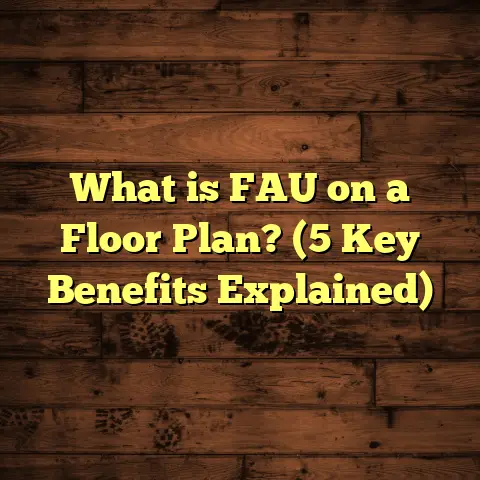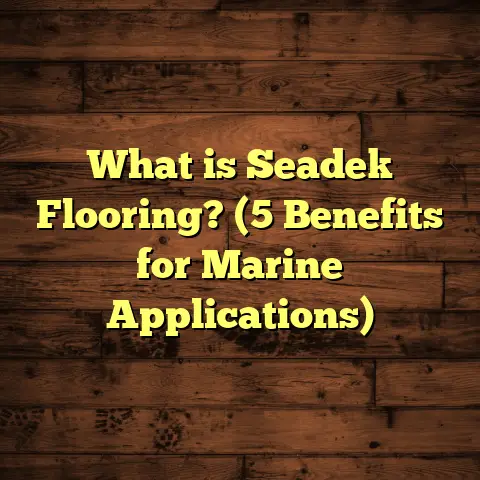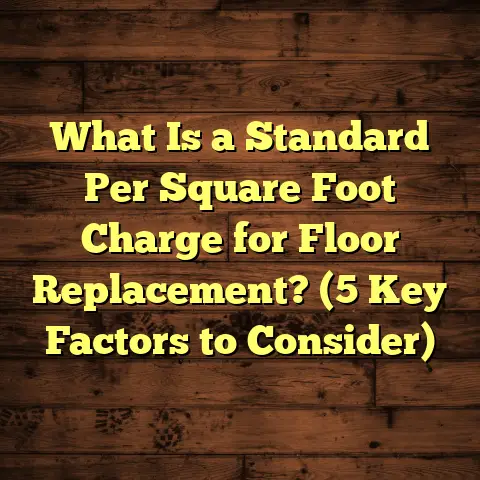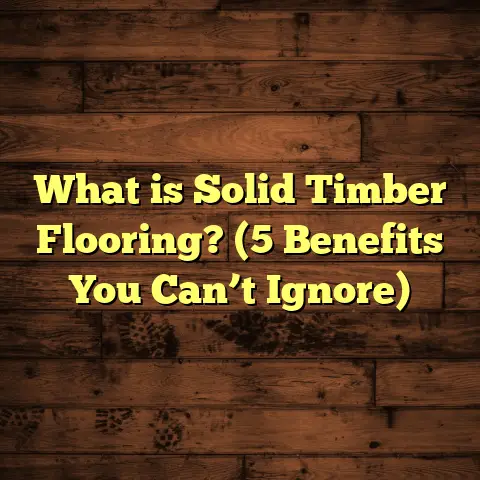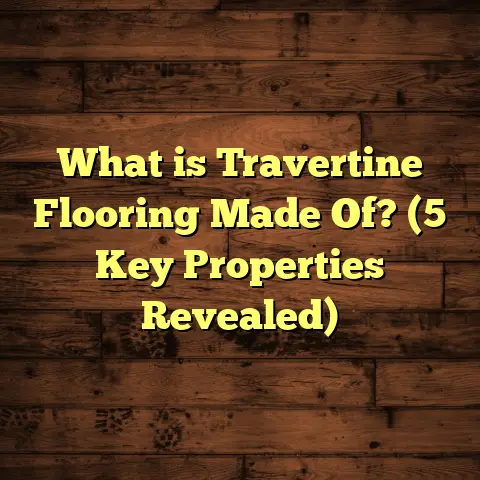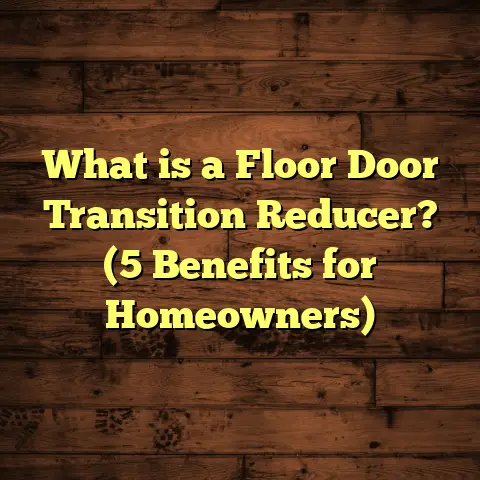What is VP Flooring? (5 Key Benefits You Must Know!)
I still remember the first time I came across VP flooring on a job. It was a small kitchen renovation project in a cozy suburban home. The homeowners were torn between hardwood and laminate floors. But I suggested vinyl plank flooring as an alternative—and it turned out to be a game changer for them. Watching that space transform was fascinating, and since then, I’ve used VP flooring in dozens of projects with great results.
Maybe you’ve heard about VP flooring but aren’t quite sure what it is, or why it’s becoming one of the fastest-growing flooring choices in both residential and commercial spaces. If you’ve got questions like “Is it durable enough?”, “How does it compare to hardwood or laminate?”, or “Is it easy to install?”, you’re in the right place.
Let me walk you through everything about VP flooring—the basics, the benefits, the science behind it, and even some real-world examples from my own work that show why this flooring option is worth your consideration.
What is VP Flooring?
VP flooring stands for Vinyl Plank flooring. It’s a type of synthetic flooring designed to look and feel like natural hardwood planks but made primarily from vinyl compounds.
Here’s what makes up a typical VP plank:
- Wear Layer: This is a clear, protective coat that shields the floor from scratches, stains, and daily wear and tear. Thickness varies by product and use case.
- Printed Design Layer: A high-resolution image layer printed with wood grain, knots, or stone patterns that give the plank its realistic appearance.
- Core Layer: Provides stability and support. This can be traditional solid vinyl or enhanced with a rigid core made from materials like WPC (wood plastic composite) or SPC (stone plastic composite).
- Backing Layer: The bottom layer adds balance and sometimes soundproofing or moisture resistance.
Vinyl plank flooring is part of a broader category called resilient flooring because it has a degree of flexibility and resistance to damage compared to hard surfaces like tile or wood.
How does VP Flooring differ from other flooring types?
You might be wondering how vinyl plank compares to laminate, hardwood, or tile floors. It helps to understand what sets VP apart:
- Compared to Hardwood: Hardwood floors are natural wood, prized for their beauty but prone to scratches, dents, and water damage. They can also be costly and require refinishing over time. Vinyl planks mimic wood’s look but resist moisture and abrasion much better.
- Compared to Laminate: Laminate floors have a fiberboard core with a printed surface covered by a wear layer. While laminate can look great, it doesn’t handle moisture as well as vinyl planks. VP flooring is waterproof due to its vinyl composition.
- Compared to Tile: Tiles are durable but often cold and hard underfoot. Vinyl plank flooring offers warmth and comfort while being easier to install and less expensive.
What types of VP Flooring are available?
There are several varieties of vinyl plank flooring you’ll encounter:
- Solid Vinyl Plank: Traditional vinyl planks made entirely from vinyl layers.
- WPC (Wood Plastic Composite): These have a thicker core made from wood-plastic mix, offering better cushioning and sometimes sound absorption.
- SPC (Stone Plastic Composite): These have a more rigid core made from limestone powder and plastic, making them extremely dense, durable, and stable—ideal for heavy commercial use.
- Luxury Vinyl Plank (LVP): A term often used interchangeably with VP flooring but generally refers to higher-end options with thicker wear layers and enhanced design features.
Each type has its strengths depending on where you plan to install it.
1. Durability That Keeps Up With Life
When I first started installing VP flooring, I was curious about how well it would hold up over time. After all, durability is one of the first things clients ask about. Will it scratch easily? Can it stand up to pets? What about heavy furniture?
Real-world durability
In my experience, vinyl plank floors are incredibly tough. The secret lies in the wear layer—a transparent coating that protects the design beneath from scratches, stains, and scuffs. The thickness of this wear layer plays a big role in durability:
- 6 mil (0.15 mm) wear layers are common in budget vinyl plank floors but are best suited for low-traffic residential areas.
- 12 mil (0.3 mm) wear layers are considered residential-grade and can handle typical household wear.
- 20 mil (0.5 mm) or higher wear layers are commercial-grade, able to withstand heavy traffic and rough conditions.
For example, in one project with a client who runs a busy café, we installed SPC vinyl plank flooring with a 20 mil wear layer. Even after two years of constant foot traffic, spills, and moving tables around, the floor still looked almost new.
Resistance to scratches and dents
Unlike hardwood floors that can dent or scratch easily from pet claws or dropped objects, VP flooring resists these problems well. The wear layer acts as armor. Plus, because vinyl is softer than wood, it absorbs impacts without cracking.
According to the Resilient Floor Covering Institute (RFCI), high-quality vinyl plank floors can last 10 to 20 years with proper maintenance—which matches or exceeds many hardwood floors’ lifespan without needing costly refinishing.
How do different cores affect durability?
The core material also impacts durability:
- WPC cores offer some flexibility which can be great for comfort but might dent under very heavy furniture.
- SPC cores are rock solid—ideal for places where you expect heavy use or rolling loads like office chairs.
I often recommend SPC for commercial spaces or homes where durability is non-negotiable.
2. Water Resistance That Protects Your Investment
Water damage is a nightmare for many homeowners. Hardwood floors can warp or swell when exposed to moisture. Laminate floors tend to peel or bubble when wet.
That’s where vinyl plank flooring shines.
Why is VP flooring waterproof?
Vinyl itself is a waterproof material. Unlike wood-based products, there’s no cellulose or wood fiber in the core that can absorb water. The surface layers are sealed tightly against moisture penetration.
During one basement renovation for a family that had previous flooding issues, we installed SPC vinyl planks specifically because they could handle dampness without warping or mold growth.
Can standing water damage vinyl plank floors?
While vinyl planks tolerate water better than most floorings, prolonged standing water isn’t ideal—especially if water seeps beneath the planks through gaps or damaged seams. However, most modern VP products have tight locking systems that minimize this risk.
A great example comes from a restaurant client who had occasional kitchen spills and mop water on their floors daily. The vinyl plank floors held up perfectly with no swelling or delamination after years of use.
Moisture barriers and subfloors
To maximize water resistance, I always recommend installing a moisture barrier underneath vinyl plank floors when laying over concrete slabs or basements prone to humidity. This extra step prevents moisture vapor from causing issues beneath the floor.
3. Easy Installation That Saves Time and Money
One of my favorite parts about working with VP flooring is how straightforward the installation process is compared to hardwood or tile.
Click-lock floating installation
Most vinyl plank floors come with a click-lock system—a tongue-and-groove design allowing planks to snap together easily without glue or nails. This floating floor method means you don’t have to mess with adhesives that require drying time or complicated tools.
I once helped my sister install VP flooring in her living room over a weekend—no contractors needed! We finished in less than two days using just a utility knife and tapping block.
Can you install VP flooring yourself?
If you’re handy and patient, DIY installation is definitely doable—especially for smaller rooms or simple layouts.
Key steps include:
- Preparing the subfloor so it’s clean, flat, and dry.
- Laying down an underlayment if required (some planks come with pre-attached underlayments).
- Clicking planks together along walls working your way across the room.
- Cutting planks to fit around corners or obstacles using a utility knife.
If the area has complicated layouts or heavy furniture to move afterward, hiring a pro might save headaches—but many homeowners successfully install VP floors themselves.
Installation time comparison
For professionals like me, installing vinyl planks cuts down labor time considerably compared to hardwoods that require nailing down each board plus sanding and finishing on-site.
According to HomeAdvisor data:
- Vinyl plank installation averages $2–$7 per square foot (including labor).
- Hardwood installation typically costs $8–$15 per square foot due to extra steps involved.
This means choosing VP flooring can save thousands on labor costs alone in larger projects.
4. Style Variety That Fits Any Space
When people think about vinyl floors, some imagine cheap-looking plastic sheets—nothing could be further from reality today.
Realistic designs and textures
Thanks to advances in printing technology and embossing techniques, vinyl planks can replicate natural wood grain patterns with remarkable detail—even mimicking distressed wood, hand-scraped textures, and exotic species like hickory or teak.
Some manufacturers even add multi-layer embossing so you feel the grain underfoot just like real wood.
In one recent project—a chic urban loft—we chose wide gray oak-look vinyl planks that matched the minimalist decor perfectly. Visitors kept asking if it was hardwood!
Color options galore
Vinyl plank flooring comes in an incredible range of colors—from classic warm browns to cool grays, whites, and even bold patterns mimicking exotic woods or stones.
Whether your style is rustic farmhouse or sleek modern minimalism, there’s almost certainly a VP product that fits your vision.
Can VP flooring be customized?
While mass-produced planks cover most styles homeowners want, some manufacturers offer custom printing options for larger commercial projects if you want specific branding or patterns embedded into flooring designs.
5. Low Maintenance That Fits Busy Lives
Life gets busy—we don’t want our floors demanding hours of cleaning every week.
Vinyl plank floors shine here too because they’re incredibly easy to care for:
Simple cleaning routines
Regular sweeping or vacuuming keeps dirt and grit from scratching surfaces. A damp mop with mild soap cleans up spills quickly without damaging the floor’s finish.
I worked with one elderly client who appreciated not needing special cleaners or waxes like she used with her old hardwood floor before switching to vinyl plank.
No refinishing needed
Unlike hardwood floors that need sanding and refinishing every few years (which can be costly), vinyl plank floors keep their look for years thanks to the durable wear layer protecting them.
Annual maintenance is mostly about keeping them clean—not restoring damaged surfaces.
Resistant to stains and fading
High-quality vinyl plank floors resist stains from common household items like wine, coffee, pet accidents, or shoe marks. Plus many have UV-resistant coatings that reduce color fading from sunlight exposure—great if your room has large windows.
Additional Insights: Environmental Impact & Indoor Air Quality
You might wonder about environmental concerns or health impacts related to vinyl plank flooring.
Are vinyl floors eco-friendly?
Vinyl production uses PVC plastics derived from fossil fuels—so there are environmental considerations during manufacturing. However:
- Many brands now offer FloorScore certification, meaning their products meet strict indoor air quality standards for low VOC emissions.
- Some manufacturers use recycled materials in production or have recycling programs for old planks.
In my experience advising clients sensitive to chemicals or allergies, selecting certified low-VOC vinyl plank products made them comfortable installing these floors inside their homes without worries about off-gassing.
Longevity reduces waste
Because VP flooring lasts longer than cheaper alternatives like carpet or laminate (which may need replacement sooner), fewer resources go into repairs or disposal over time—making it a more sustainable option long-term if well-maintained.
Case Studies From My Projects
Let me share some examples from my recent projects illustrating how versatile and beneficial VP flooring can be:
Case Study 1: Family Kitchen Remodel
- Location: Suburban home
- Area: 800 sq ft kitchen/dining
- Product: 12 mil wear layer WPC vinyl plank in oak finish
- Budget: $3,200 installed
- Outcome: Homeowners love how easy it is to clean after cooking messes; floor shows no wear after 18 months despite kids running around.
Case Study 2: Commercial Office Space
- Location: Downtown office
- Area: 2,000 sq ft open workspace
- Product: SPC vinyl plank with 20 mil wear layer
- Budget: $12,000 installed
- Outcome: Floor resists chair movement scratches; employees comment on comfort underfoot; maintenance team reports easy cleaning.
Case Study 3: Basement Conversion
- Location: Basement turned media room
- Area: 500 sq ft
- Product: Waterproof SPC planks with attached underlayment
- Budget: $2,500 installed
- Outcome: Floor remains stable despite occasional humidity; client notes warmth and noise reduction compared to tile previously installed.
Common Questions I Get About VP Flooring
Here are some of the questions I get frequently from clients thinking about switching to vinyl plank floors:
Q: Can I install VP flooring over existing hardwood?
Yes! As long as the old floor is level and in good condition without major damage or movement risks. Floating installation allows placing planks right over existing surfaces in many cases.
Q: Will VP flooring feel cold like tile?
Vinyl plank tends to feel warmer underfoot than tile because of its slight flexibility and construction materials. Adding an underlayment can improve comfort further.
Q: How do I repair damaged planks?
Minor scratches can sometimes be buffed out depending on finish; damaged planks usually need removal and replacement which is easier with floating click-lock systems than glued-down types.
Q: Is VP flooring pet-friendly?
Absolutely! It resists scratches better than hardwoods and cleans easily after accidents. The waterproof nature also helps avoid stains or odors seeping into the floorboard layers.
Wrapping Up My Thoughts on Vinyl Plank Flooring
After working hands-on with countless flooring materials over my career—from traditional hardwoods to cutting-edge laminates—I’ve seen how vinyl plank flooring stands out as a practical choice that combines style with resilience at an attractive price point.
You get:
- Long-lasting durability backed by measurable wear-layer specs
- Superior water resistance protecting your investment
- Quick installation options saving time and labor costs
- Style options that rival natural wood
- Low-maintenance routines fitting busy lifestyles
If you’re remodeling your home or upgrading commercial space surfaces soon, giving VP flooring serious thought could save you time, money, and headaches down the road.
Have questions about specific brands or installation tips? Want advice tailored to your project? Just ask—I’m happy to share what I’ve learned through years installing these versatile floors firsthand!
